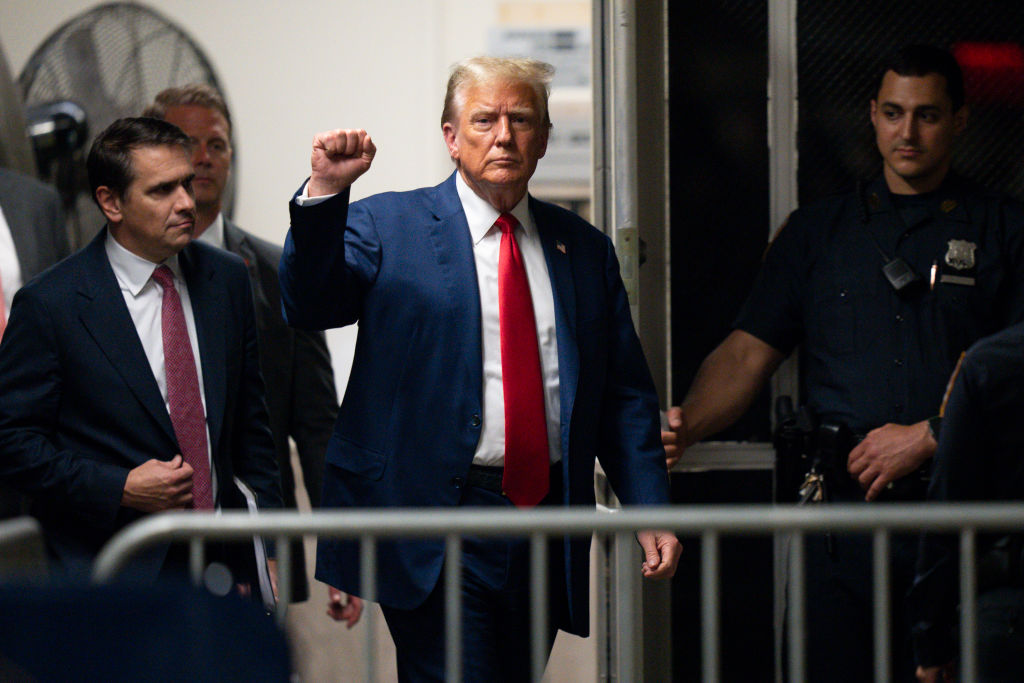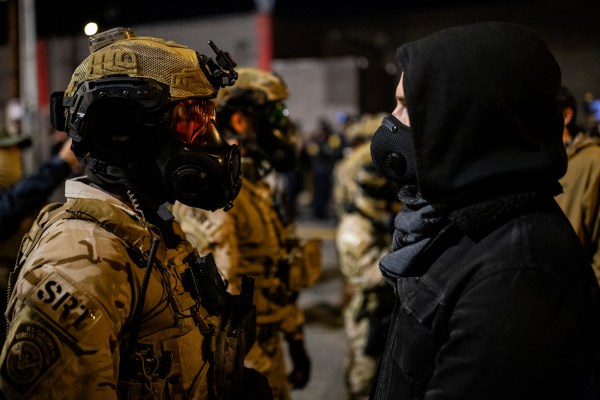Former President Donald Trump faces two potential paths to incarceration regarding his Manhattan trial over hush money payments made to a porn star. Trump could be convicted of at least some of the criminal charges against him or he could be jailed for being in contempt of court.
How would it work if Trump gets locked up?
The short answer is that nobody really knows—including, very likely, jail administrators. The New York Times recently reported that officials have been meeting to attempt to work out how incarceration arising from a contempt citation would work, but they have not yet begun to plan for any possible post-conviction incarceration. Still, examining the most appropriate historical precedent and the policies governing the operations of both city and state penal systems in New York offer clues.
Eugene Debs in prison.
In 1918, Eugene Debs was a four-time presidential candidate for the Socialist Party though by then was in poor health and largely retired. Debs gave a speech in which he criticized the Woodrow Wilson administration’s jailing of people speaking against World War I. Debs was charged with violating the Espionage Act, convicted, and sentenced to 10 years. He served the first two months of his sentence in a state penitentiary in West Virginia before being transferred to a federal prison in Atlanta. In 1920, the Socialist Party nominated him as its presidential candidate for a fifth time.
In his book Democracy’s Prisoner: Eugene Debs, the Great War, and the Right to Dissent, Ernest Freeberg explains that in both prisons, wardens interpreted prison rules loosely for Debs. He was lodged in shared cells with other prisoners but was assigned to light physical labor in the hospital for his work assignment. Inmates were permitted to receive unlimited mail, but could send only one letter per week. The wardens allowed Debs to write brief notes on his incoming mail, which was then forwarded to Debs’ brother to convert into proper responses. When Debs was nominated, he was allowed to campaign by writing a 500-word article per week. As Election Day approached, reporters were allowed into the prison to interview the candidate.
What if Trump is jailed for contempt of court?
If Trump is incarcerated by Judge Juan Merchan for contempt of court, two New York City Department of Correction policy documents will form the foundation of how officials deal with the situation.
Directive 4020R-B defines 20 categories of inmates. For a contempt-of-court citation, Trump would be categorized as a “civil case inmate.” In practical terms, this would mean that he would be spared the indignities of the normal intake process such as a medical screening, strip search, and mandatory change into prison clothing. Trump’s avoidance of these unpleasant experiences would be standard policy rather than any special treatment. The legal logic is that he is being incarcerated for something other than being charged or convicted of a specific criminal offense. As a result, being treated “like a criminal” is held to a minimum.
Directive 6007R-A mandates that the New York City Department of Correction assign vulnerable inmates to protective custody units. This ensures that Trump would not enter a jail’s general population. Even without the risks arising from his notoriety, Trump’s age would likely cause him to be placed in protective custody. In the last quarter, on an average day there were 6,207 inmates locked up by the City of New York. Only 22 were over the age of 70. In a jail population with lots of churn, advanced age is an indicator of vulnerability.
Apart from the type of incarceration Trump would endure in such a scenario, most incarcerations arising from a contempt of court citations are short. Trump would likely spend a few hours—maybe as much as a night—in a holding cell within the courtroom with Secret Service nearby to maintain watch. According to Corrections Department policy, Trump would be required to clean his own living space. Other than that, the real punishment would be the symbolism of having been jailed. In theory, he could end up wearing handcuffs for a few minutes, but even that is probably unlikely.
Incarceration after a conviction.
Even if Trump is convicted of the charges, the chances of him following in the footsteps of Eugne Debs and campaigning from prison are essentially non-existent.
New York state law provides for either a stay of sentence or release on recognizance/bail pending an appeal. If convicted, Trump would be:
- a first-time offender,
- Due to his age considered a vulnerable inmate, and
- in possession of a demonstrated record of showing up for his court appearances and not considered a flight risk.
Let’s return to our only historical example. Debs stayed out of prison until after his appeal was heard by the United States Supreme Court: 208 days elapsed between his conviction and the beginning of his incarceration.
The New York charges Trump is now on trial for are classified as a Class E felony and carry a sentencing range from probation to a maximum of four years in prison. In theory, Judge Merchan could impose the maximum sentence for each conviction to be served consecutively. Given that Trump’s alleged crime has been subdivided into 34 counts, some impressive jail time is theoretically possible. New York law caps the total sentence for Class E felonies at 20 years, which effectively mean a life sentence for a 77-year-old.
But that almost assuredly will not happen. The normal sentence for the charges Trump is facing ranges from probation to about two years.
If Trump is sentenced to less than one year, the New York City Department of Correction would get the honor of dealing with the resulting headache (which includes figuring out how Secret Service protection factors into the incarceration). A sentence of more than a year would punt it to the New York State Department of Corrections and Community Service. Officials in both jurisdictions are probably praying the other gets responsibility. For both, the combination of Trump’s unique prison vulnerability, profile, and Secret Service protection would likely mean an unused section of an existing facility would have to be activated or some other structure would have to be designated as a temporary correction facility.
Jail and prison administrators have the legal and moral mandate to keep inmates safe from harm, and most take this mandate seriously. They would take it very seriously for an inmate who was a former president. The resulting unique circumstances and risk profile would inevitably mean that Trump would receive “special treatment” to ensure his safety.






Please note that we at The Dispatch hold ourselves, our work, and our commenters to a higher standard than other places on the internet. We welcome comments that foster genuine debate or discussion—including comments critical of us or our work—but responses that include ad hominem attacks on fellow Dispatch members or are intended to stoke fear and anger may be moderated.
With your membership, you only have the ability to comment on The Morning Dispatch articles. Consider upgrading to join the conversation everywhere.